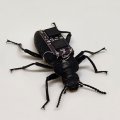A University of Queensland Arts/Engineering graduate who has undertaken work on a new ground based test facility for spacecraft has received the inaugural national award for the best undergraduate thesis in space engineering.
Will Mulholland was presented with the award at the Australian International Aerospace conference in Canberra this month.
The award is an initiative of the National Committee on Space Engineering, affiliated with the Institute of Engineers, Australia.
Mr Mulholland completed a five year Bachelor of Engineering in Mechanical and Space Engineering (honours)/Bachelor of Arts (psychology) in December.
His honours thesis in high speed gas dynamics, supervised by the Director of the UQ's Centre for Hypersonics, Associate Professor Richard Morgan, examined aspects of the design and commissioning of a new facility for the University's Mechanical Engineering Department.
"Specifically, Richard was hoping to expand the Centre for Hypersonics facilities with a free flight simulator/launcher," Mr Mulholland said.
"The Centre currently has a number of ground based test facilities for space craft testing known as shock tunnels and expansion tubes, which are used to develop high speed gas as in a wind tunnel.
"A spacecraft or aircraft model is placed in the test section and measurements of flight conditions and craft performance are taken. Conditions such as local temperature and pressure of the craft can be measured, as well as lift, and drag."
Instead of placing fixed models in a stream of moving gas, it is also possible to launch a model of a spacecraft out of a gun and send it through a stationary region of gas. All spacecraft launched by NASA have been put through a rigorous testing program involving stationary (wind tunnel) and free flight (light gas gun) testing.
Mr Mulholland said Professor Morgan hoped to convert an old free-piston driver into a new dual purpose light-gas gun/ relected shock tunnel at UQ.
"It was my task to first understand the gas dynamics within the system," he said. "I then had to research which parameters were important to design a suitable extension for the unused driver in the department. Once I had completed the design and had the extensions manufactured (within the Department) I performed a series of experiments to report on the performance of the device.
"As a light gas gun, models 1 inch in diameter were launched from the facility at speeds of up to 2km/second. This provided useful test conditions for future student work.
"Overall, I think the facility will be extremely useful as an experimental tool for future students. Since my experimental work was at the preliminary stage, future students are developing and understanding the operation of the facility."
Mr Mulholland said he believed that opportunities available to students within UQ's Mechanical Engineering Department were "endless".
"Without the support of my friends and the staff and students of the Mechanical Engineering Department this award would not have been mine to receive. I owe a great debt to the workshop staff and my supervisor Professor Morgan.
"In my last year I was also given the opportunity to work with another pioneering researcher Dr Allan Paull, whose team hopes to become the first research group in the world to test an air-breathing scramjet in actual flight conditions later this year at Woomera.
"In a team of four undergraduates it was our task to verify the design of the HyShot nosecone ejection system, to be used on board the HyShot launch for July 2.
Mr Mulholland is now undertaking postgraduate research at the University of Oxford with Professor Brian Bellhouse and Dr Mark Kendall at the PowderJect Centre for Gene and Drug Delivery Research, which investigates the fundamentals of needle-free drug delivery systems.
These hand-held systems deliver drugs and vaccines into the human skin and mucosa. The drugs are formulated in particle form and then entrained in a gas flow to impact the skin at velocities the order of 500metres/second.
The particles come to rest within the epidermis of the skin, dissolve and diffuse to provide a therapeutic effect.
Mr Mulholland's project is investigating the impact mechanics of particles with the tissue.
"Oxford has been wonderful so far. I have to say I wouldn't be there if it wasn't for the high standard of teaching and research opportunities made available at UQ," he said.
For further information, contact Mr Mulholland, email: william.mulholland@st-catherines.oxford.ac.uk
.jpg)

